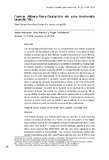| dc.rights.license | http://creativecommons.org/licenses/by-nc-sa/3.0/ve/ | |
| dc.contributor.author | Andrades, Jesús | |
| dc.contributor.author | Barrios R., Alex G. | |
| dc.contributor.author | Valladares, Roger | |
| dc.date.accessioned | 2014-12-10T03:38:04Z | |
| dc.date.available | 2014-12-10T03:38:04Z | |
| dc.date.issued | 2014-12-10T03:38:04Z | |
| dc.identifier.issn | 0798-2437 | |
| dc.identifier.uri | http://www.saber.ula.ve/handle/123456789/39456 | |
| dc.description.abstract | Las curvas Altura-Área-Duración son un procedimiento que intenta reconstruir
la variación espacio-temporal de una tormenta extrema, para elaborar dicho
análisis se pueden aplicar dos métodos (Isoyético Incremental y Curva Másica),
en este estudio se comparó la elaboración de las curvas por ambos métodos,
aplicándolos a la tormenta ocurrida el 28-04-1972 sobre la cuenca del río Chama
y cuyo el pico máximo fue registrado por la estación Hidrométrica Chama-Ejido.
El método Isoyético Incremental se realizó interpolando con Kriging Lineal
para un tamaño de pixel constante de 100 m, y luego filtrando las horas de las
distintas duraciones para así obtener la máxima precipitación absoluta para un
área y una duración determinada. En el método de la Curva Másica se aplicó
el enfoque de reconstruir la tormenta a partir del supuesto de que el evento
tiene un patrón de variación espacio-temporal similar al del total de duración
del mismo y mediante una reconstrucción se elabora con las curvas para las
distintas duraciones. Se partió de la duración de la totalidad de la tormenta
de estudio (6 horas) interpolada con Kriging y de tamaño de pixel de 100 m.
Los resultados muestran que existen diferencias sustanciales en la elaboración
de las curvas en superficies mayores a 100 km2, y cuando las duraciones son
menores a cuatro horas, esto es debido a que el método de la curva másica
toma en cuenta el patrón de variación espacio-temporal del evento. | es_VE |
| dc.language.iso | es | es_VE |
| dc.rights | info:eu-repo/semantics/openAccess | |
| dc.subject | Análisis de tormentas | es_VE |
| dc.subject | Filtros digitales | es_VE |
| dc.subject | Modelado | es_VE |
| dc.subject | SIG | es_VE |
| dc.title | Curvas Altura-Área-Duración de una tormenta usando SIG | es_VE |
| dc.title.alternative | Depth-Area-Duration Curve of a storm using GIS | es_VE |
| dc.type | info:eu-repo/semantics/article | |
| dc.description.abstract1 | The Rainfall Analysis is a method which has the purpose to reconstruct the
spatial and temporal variation of a Storm. For the elaboration of the Depth-
Area-Duration curve (DAD) two methods (Isoyetic Incremental and Mass Curve)
were used. This study is a comparison of both methods applied to the same
Storm event occurred the 28-04-1972, with the max value registered in the
hydrometric station of Chama-Ejido. The Isoyectic Incremental method was
applied interpolating grids with Lineal Kriging with the pixel size of 100 m, then it was applied an average filter with a kernel of variable size for the different duration, in order to identify the absolute maximum precipitation for a given area and duration. The Curve Mass method was applied in order to reconstruct the storm, based in the similarity supposition between the spatial-temporal pattern and the storm total duration (6 hours). For the reconstruction was used the storm total duration (6 hours) with Lineal Kriging and pixel size of 100 m. The results show a noteworthy difference when the duration is less to four hours, and the areas superior to 100 km2, because the mass curve method does not represent the spatial and temporal variation of the precipitation on the storm. | es_VE |
| dc.description.colacion | 22-35 | es_VE |
| dc.description.email | andradesjesus@yahoo.com | es_VE |
| dc.description.email | alexb@ula.ve | es_VE |
| dc.identifier.depositolegal | 198102ME433 | |
| dc.subject.facultad | Facultad de Ciencias Forestales y Ambientales | es_VE |
| dc.subject.institutoinvestigacion | Instituto Forestal LatinoAmericano (IFLA) | |
| dc.subject.keywords | Rainfall analysis | es_VE |
| dc.subject.keywords | Filter | es_VE |
| dc.subject.keywords | Modeling | es_VE |
| dc.subject.keywords | GIS | es_VE |
| dc.subject.publicacionelectronica | Revista Forestal Latinoamericana | |
| dc.subject.seccion | Revista Forestal Latinoamericana: Artículos | es_VE |
| dc.subject.thematiccategory | Geografía | es_VE |
| dc.subject.thematiccategory | Medio Ambiente | es_VE |
| dc.subject.tipo | Revistas | es_VE |
| dc.type.media | Texto | es_VE |


